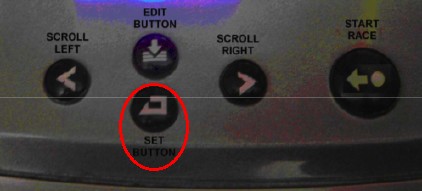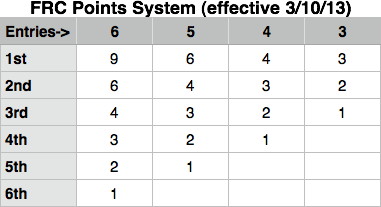FRC General Competition Regulations
Posted: Fri Feb 05, 2010 11:18 am
FRC GENERAL COMPETITION REGULATIONS
General:

Stewards:
The marshal standing on the "Control Tower" stool will automatically be nominated the Steward of the race which is about to be started. If this person lacks the experience deemed necessary, a different marshal shall be nominated and will take over this position on the stool.
Steward's responsibilities:
Penalties: 2018-04-05 - Most if not all of these no longer apply since the introduction of track power kill switches.
At each event a driver's championship will be decided for each class run. Points will be awarded to drivers for each race based on their finishing position as indicated on the Power Base, according to the following table:
https://www.frcforum.com/viewtopic.php?f=6&t=722
In addition, the fastest qualifier in each class will be given a bonus point.
General:
- Excluding any exceptions listed below, placing a car on the track must always be done in the pit lane.
- With the exception of the conclusion of a race, stopping a car to remove it from the track must always be done in the pit lane.
- The Power Base is always considered correct and its results cannot be disputed.
- Any form of liquid refreshment is prohibited from the track table and the controller station.
- Driving through a slower car on the track should be avoided at all times when operating a car on the track (this includes informal practice/test sessions as well as races). All overtaking should be done using the lane changers.
- A minimum of 3 starters are required to constitute a points-scoring race or rally stage.
- Cars will do a single warm-up lap followed by three timed laps. Fastest lap will be its qualifying time.
- If a car de-slots during its warm-up lap, it may be re-slotted to start its qualifying session.
- If a car de-slots after starting but before completing its first timed lap, its qualifying session is over and it will be placed off the track alongside its de-slot location. All cars without a time will be gridded behind those with times, with cars that completed more of the lap ahead of others.
- If a car de-slots after completing at least one timed lap, its qualifying session is over.
- Qualifying will be done in one or more x-minute sessions with up to six cars at a time, using the Power Base qualifying feature (x to be decided at the event).
- Classes will qualify in separate sessions (no mixed-class sessions).
- A driver may not qualify more than one car per class or the same car in more than one qualifying session for the class.
- Cars will do a single warm-up lap followed by three timed laps. Fastest lap will be its qualifying time.
- If a car de-slots during its qualifying laps, it may be re-slotted to continue its qualifying session.
- Cars are gridded for the first race based on their qualifying times, lowest times at the front. Thereafter cars are gridded based on their previous race finishing positions.
- If a car other than the one used for qualifying is to be raced, such car must start from the back of the grid for its first race. The same applies to any other car changes in subsequent races.
- In the event that there are more than six and less than nine entries, excess drivers will cycle out for each race. For example, if there are eight entries, the last two qualifiers will sit out the first race. Thereafter, the last two finishers in each race will step out to allow the previous two to take their places.
- If there are nine or more entries in a class, the class will be split into sub-groups (A, B, C. etc.), according to the following:
- 9 or 10 entries - first 5 in sub-group A, rest in sub-group B.
- 11 or 12 entries - first 6 in sub-group A, rest in sub-group B.
- 13 or 14 entries - first 6 in sub-group A, next 6 in sub-group B with the excess drivers cycling out.
- 15 or 16 entries - first 6 in sub-group A, next 5 in sub-group B, rest in sub-group C.
- etc.
- Races take place either over a fixed number of laps ("Grand Prix" - referred to as GRP on the Power Base) or time period ("Enduro" - END on the Power Base). Number of laps per race (or time per race) and number of races per class will be decided at each event.
- For each class, cars are gridded based on their qualifying times for the first race, thereafter based on the previous race finishing positions.
- A car may be substituted for another provided it complies with the class requirements, however substitutions cannot take place during a race.
- Races will not be stopped to facilitate repairs to competing cars. If a car suffers damage or mechanical/electrical issues during a race and cannot continue, it must be removed from the track, but can rejoin the race from the pits if repaired.
- Damaged cars may be allowed repair time between races if time permits.
- For each class (with the exception of our "IROC" classes), drivers are allocated to hand controller stations based on their qualifying grid positions and race there for all the races in that class for the event. Fastest qualifier uses Station 1, second uses Station 2, etc. For "IROC" races, drivers start the first race at whichever station they are allocated (based on qualifying or a dice roll), then rotate to the next station in sequence for each race.
- Once passing technical inspection, competing cars may not be removed from the Parc Ferme area. Parc Ferme is defined as the track paddock, track pit area, starting grid and driver stations. IROC cars may not be removed from these areas at any time other than for repairs.
- If a car de-slots during a race and no marshals are present, the driver must retrieve it himself, making a lap around the track table in a clockwise direction, regardless of where the the car has been retrieved. Cars retrieved in this manner must always be re-slotted it in the pit lane. 2018-04-05 - This rule no longer applies. Instead, drivers must use their kill switch button as a "track call", killing power to the rails. The offending car must then be re-slotted a fixed distance back from where it came off and the race resumed by the car's driver re-activating track power.
- The winning car will automatically slow on crossing the finish line. All subsequent cars will do likewise as they cross the line after the winner.
- Once all starters have crossed the finish line at race end, throttles are automatically disabled and the results are displayed on the Power Base.
- In the event that there is at least one non-finisher, the results can be displayed by pressing the "Set" button (NOTE: THIS SHOULD ONLY BE DONE AFTER THE RACE END, otherwise the race will end prematurely):

Stewards:
The marshal standing on the "Control Tower" stool will automatically be nominated the Steward of the race which is about to be started. If this person lacks the experience deemed necessary, a different marshal shall be nominated and will take over this position on the stool.
Steward's responsibilities:
- The primary responsibility of the Steward is to ensure fairness in driving during races. Stewards may assign a stop-and-go penalty to any offending driver.
- Calling race starts in lieu of using the automatic PowerBase start (for example, when start overloads occur).
- Stopping races in progress if he deems a situation on track requires this.
- Restarting stopped races.
- A race should be stopped when one or more de-slotted cars which cannot be easily removed are blocking the track.
- A race should not be stopped for a de-slotted car which is not blocking the track, except at the discretion of the Steward.
Penalties: 2018-04-05 - Most if not all of these no longer apply since the introduction of track power kill switches.
- If a car drives through or bounces a car ahead in the same lane causing it to de-slot, or if a car exiting the pits or changing lane causes another car to de-slot, the offending car must do a stop-and-go penalty in the pits (usually called a "drive-through" penalty). This penalty may be assigned by a Steward or the victim or in the interest of sportsmanship, the offender may call a "drive-through", identifying the offending car by its colour, number or driver. If the offending car cannot be identified, this will be considered a racing incident and no penalty will apply.
- In the interest of fair play, a driver may impose a "drive-through" penalty on himself if he realizes that he is guilty of item 1 above.
- A separate penalty must be served for each "drive-through" incident. If a driver causes more than one "drive-through" incident, a penalty will apply for each incident.
- A "drive-through" penalty is served by entering the pit lane, coming to a complete stop, then resuming the race via the pit exit. This can be done at any time before the race ends. The driver must indicate that the drive through was done by clearly announcing "Drive through taken" otherwise the penalty will be considered not served.
- Failure to serve all pending "drive-through" penalties by race end will automatically demote the offending car to last place in the race, regardless of actual finishing position. This applies even if there are not enough remaining laps available to serve the penalty.
- At the start of a race, any car that de-slots or is de-slotted by another car between its starting position and the end of the first corner may be re-slotted immediately without penalty.
- Big Men Clause
If a disputed drive-through cannot be resolved before the results for the race in question are recorded, the two drivers involved will be demoted to the two final race positions in that race's results, relative to their actual finishing positions in the race.
At each event a driver's championship will be decided for each class run. Points will be awarded to drivers for each race based on their finishing position as indicated on the Power Base, according to the following table:
- 1st place - 9 points
- 2nd place - 6 points
- 3rd place - 4 points
- 4th place - 3 points
- 5th place - 2 points
- 6th place - 1 point
Effective October 3rd 2013, the new points system is as follows:

https://www.frcforum.com/viewtopic.php?f=6&t=722
In addition, the fastest qualifier in each class will be given a bonus point.